Ghrelin reduces hypertonic saline intake in a variety of natriorexigenic conditions
- PMID: 21784787
- PMCID: PMC3173603
- DOI: 10.1113/expphysiol.2011.059535
Ghrelin reduces hypertonic saline intake in a variety of natriorexigenic conditions
Abstract
Ghrelin is a gut peptide that has been studied extensively for its role in food intake and energy balance. More recent studies show that ghrelin reduces water intake in rats and some non-mammalian species. Despite the importance of the regulation of NaCl intake in body fluid homeostasis, the effects of ghrelin on saline intake have not been investigated. Accordingly, we tested the effect of ghrelin on water and 1.8% NaCl intake in two-bottle test conditions with the following five stimuli that increase hypertonic saline intake: central angiotensin II administration; 24 h fluid deprivation; water deprivation followed by partial rehydration; dietary sodium deficiency; and polyethylene glycol administration combined with dietary sodium deficiency. We found that ghrelin attenuated saline intake stimulated by angiotensin II, by water deprivation followed by partial rehydration and by dietary sodium deficiency. We did not detect an effect of ghrelin on saline intake after 24 h fluid deprivation without partial rehydration or after the combination of polyethylene glycol and dietary sodium deficiency. The finding that ghrelin reduced hypertonic saline intake in some, but not all, natriorexigenic conditions mirrors the previously published findings that in one-bottle tests of drinking, ghrelin reduces water intake in only some conditions. The results provide evidence for a new role for ghrelin in the regulation of body fluid homeostasis.
Figures
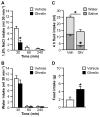
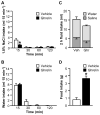
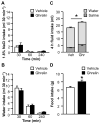
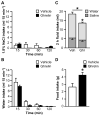
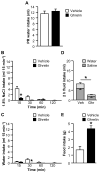
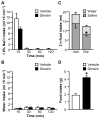
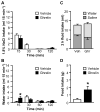
Similar articles
-
Fourth ventricle injection of ghrelin decreases angiotensin II-induced fluid intake and neuronal activation in the paraventricular nucleus of the hypothalamus.Physiol Behav. 2017 Sep 1;178:35-42. doi: 10.1016/j.physbeh.2016.11.018. Epub 2016 Nov 19. Physiol Behav. 2017. PMID: 27876637 Free PMC article.
-
The effect of ghrelin on water intake during dipsogenic conditions.Physiol Behav. 2009 Jan 8;96(1):37-43. doi: 10.1016/j.physbeh.2008.08.004. Epub 2008 Aug 11. Physiol Behav. 2009. PMID: 18761029 Free PMC article.
-
Aging and fluid homeostasis in rats.Am J Physiol. 1997 Oct;273(4):R1441-50. doi: 10.1152/ajpregu.1997.273.4.R1441. Am J Physiol. 1997. PMID: 9362310
-
Centrally administered ghrelin potently inhibits water intake induced by angiotensin II and hypovolemia in rats.J Physiol Sci. 2010 Jan;60(1):19-25. doi: 10.1007/s12576-009-0062-6. Epub 2009 Sep 18. J Physiol Sci. 2010. PMID: 19760484 Free PMC article.
-
Behavioral responses and fluid regulation in male rats after combined dietary sodium deficiency and water deprivation.Physiol Behav. 2018 Feb 1;184:162-171. doi: 10.1016/j.physbeh.2017.11.025. Epub 2017 Nov 23. Physiol Behav. 2018. PMID: 29174912
Cited by
-
Enhanced consumption of salient solutions following pedunculopontine tegmental lesions.Neuroscience. 2015 Jan 22;284:381-399. doi: 10.1016/j.neuroscience.2014.09.075. Epub 2014 Oct 8. Neuroscience. 2015. PMID: 25305665 Free PMC article.
-
Fourth ventricle injection of ghrelin decreases angiotensin II-induced fluid intake and neuronal activation in the paraventricular nucleus of the hypothalamus.Physiol Behav. 2017 Sep 1;178:35-42. doi: 10.1016/j.physbeh.2016.11.018. Epub 2016 Nov 19. Physiol Behav. 2017. PMID: 27876637 Free PMC article.
-
Roux-en-Y gastric bypass does not affect daily water intake or the drinking response to dipsogenic stimuli in rats.Am J Physiol Regul Integr Comp Physiol. 2014 Jul 15;307(2):R114-20. doi: 10.1152/ajpregu.00135.2014. Am J Physiol Regul Integr Comp Physiol. 2014. PMID: 24898844 Free PMC article.
-
The role of glucagon-like peptide-1 (GLP-1) in fluid and food intakes in vasopressin-deficient Brattleboro rats.Physiol Behav. 2023 Apr 1;262:114093. doi: 10.1016/j.physbeh.2023.114093. Epub 2023 Jan 24. Physiol Behav. 2023. PMID: 36706972 Free PMC article.
-
Fluid intake, what's dopamine got to do with it?Physiol Behav. 2021 Jul 1;236:113418. doi: 10.1016/j.physbeh.2021.113418. Epub 2021 Apr 7. Physiol Behav. 2021. PMID: 33838203 Free PMC article.
References
-
- Buggy J, Fisher AE. Evidence for a dual central role for angiotensin in water and sodium intake. Nature. 1974;250:733–735. - PubMed
-
- Cowley MA, Smith RG, Diano S, Tschop M, Pronchuk N, Grove KL, Strasburger CJ, Bidlingmaier M, Esterman M, Heiman ML, Garcia-Segura LM, Nillni EA, Mendez P, Low MJ, Sotonyi P, Friedman JM, Liu H, Pinto S, Colmers WF, Cone RD, Horvath TL. The distribution and mechanism of action of ghrelin in the CNS demonstrates a novel hypothalamic circuit regulating energy homeostasis. Neuron. 2003;37:649–661. - PubMed
-
- Cummings DE, Purnell JQ, Frayo RS, Schmidova K, Wisse BE, Weigle DS. A preprandial rise in plasma ghrelin levels suggests a role in meal initiation in humans. Diabetes. 2001;50:1714–1719. - PubMed
Publication types
MeSH terms
Substances
Grants and funding
LinkOut - more resources
Full Text Sources

